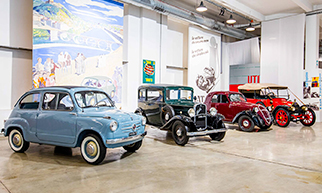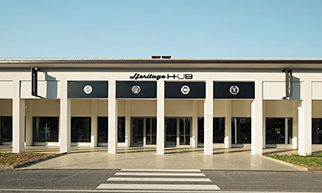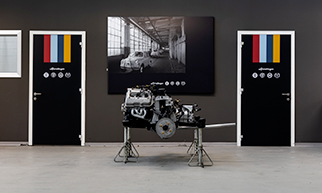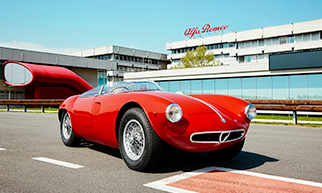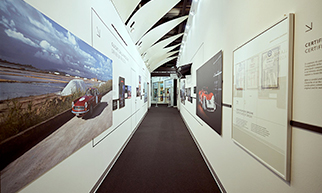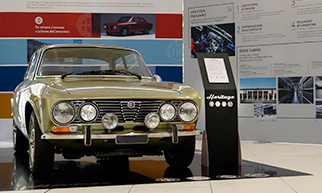Alfa Romeo is celebrating the 75th anniversary with the 75, which made its debut in May 1985 alongside the newly launched Alfa 90. Created to replace the Giulietta – from which it inherited some of the components of its bodywork – it built its great success on the development of new and higher-performance engines.
In 1982, it was becoming increasingly urgent for Alfa Romeo's management to revamp two models: the Alfetta, created in 1972, and the Giulietta, available from 1977. Two parallel projects came to be, known in-house as K2 (in mathematical notation “Kappa to the second”, but often simply “K2”) as the successor to the Alfetta, and K1, the car made to replace the Giulietta. The time frame was very tight, so the design for the bodywork of the new flagship, the K2, was passed on to Bertone, where responsibility for it fell to Marcello Gandini. Conversely, for the K1, the task was entrusted in-house to Ermanno Cressoni, Head of the Alfa Romeo Centro Stile.
Alfa Romeo’s finances at that time did not allow for creative flights of fancy: it was necessary to use as many components as possible from the models to be replaced. Therefore, both Gandini and Cressoni pulled off quite the miracle in giving a new identity, while using the “door frame”, the architrave of the entire car, as well as other elements, of the existing bodywork. Gandini focused on elegance and clean lines, whereas Cressoni brought out Alfa’s idiosyncratic sportiness. In the words of many, including the unquestionable judgment of the market, Cressoni had managed to create a design more full of identity.
The wedge-shaped profile was highlighted even further by the application of a darker band that ran along the side: from the detachment between the bonnet and mudguard to the belt line, continuing by increasing the incline to the end of the boot, plotting its rear contour to connect to the band on the other side. The inverted trapezoidal grille, with the badge in the middle, which ended with the rectangular headlights, also contributed to boosting the typical Alfa Romeo grit, and carried on in the triangular turn signal on the mudguard. The high tail was also successful, with the headlights repeating the trapezoidal pattern throughout the lower band of the boot.
The technical layout continued the path trodden by the Alfetta with its transaxle architecture: front engine with clutch, gearbox and differential in a single block in the rear. Independent suspension with torsion bar spring at the front and De Dion bridge and Watt parallelogram with coil spring in the rear, stabiliser bars and hydraulic shock absorbers on both axles.
The interior, in terms of materials and fabrics in common with the Alfa 90, was outstanding, with details more commonly seen in higher-segment cars, such as the height-adjustable steering wheel. The front seats were a perfect compromise between sportiness and comfort, whereas the rear seats were comfortable enough even for long distances. The boot was more capacious than the Giulietta's, for ideal placement of the petrol tank and spare wheel.
It was the new – constantly evolving – engines that reaffirmed Alfa Romeo's DNA and determined the success of the 75: from the 2.5 and 3-litre V6 and the 1.8i turbo to the iconic Twin Spark that would become a trademark for the Biscione brand’s cars.
At launch, three engines were presented with the traditional four-cylinder twin-cam powered by two double-barrel carburettors: 1.6 (110 hp), 1.8 (120 hp) and 2-litre (128 hp). At the top of the range was the 2.5-litre V6 with injection, the same as the Alfa 90 and fitted to the more powerful and luxurious Quadrifoglio Verde version: 156 hp, which fell to 150 in the version with a catalytic converter, known as “V6i cat” and intended for export. A great wealth of specifications for the time: from central locking to electric windows, with power steering and air conditioning available as optional extras. The final engine at launch was the emerging turbodiesel unit manufactured by VM in Cento#: a 2-litre delivering 95 hp.
The echo of the engines’ qualities reached overseas and Alfa Romeo, from the year following its launch until 1990, created four versions to be exported to the States: this was the genesis of the 75 Milano, available in the 2.5i Quadrifoglio Silver, Gold and Platinum versions with the 154-hp V6, from 1987 alongside the 3.0i Green with the 3-litre V6 that delivered 183 hp.
But it was with the Alfa Romeo 75 that, together with diesel units, turbocharging finally became a predominant part of the landscape, even for petrol units. After the experimentally tinted attempts of the Alfetta GTV 2.0 Turbodelta and the subsequent Giulietta Turbo Autodelta, it was with the advent of electronic injection that Alfa Romeo turbo petrol engines became a reality that the competition was forced to reckon with.
It all began with the 75 1.8i turbo and its 1,779-cc four-cylinder injection engine with Garret turbocharger and intercooler capable of delivering 155 hp and offering performance similar to the 2.5i V6 version. In 1987,to obtain type approval for racing, 500 units of the 75 turbo Evoluzione were produced with an entirely red livery and striking aerodynamic appendages: from the front bumper with integrated spoiler to the enlarged fenders connected by low sill skirts. Changes to the engine, with displacement slightly reduced to 1,762 cc for type-approval reasons, to the suspension and 15” wheel rims designed for 205/50 VR 15 tyres. With high-absorption, US-style bumpers, spoilers and side skirts in body colour, the 1.8i turbo America came to be.
Alongside the "turbo revolution", Alfa’s engineers drew on the glorious past to fit the naturally aspirated engines not only with electronic injection but also with dual spark plug ignition and a new Alfa patent for the timing variator. Hence the genesis of the Twin Spark family of engines, which became a true trademark and hallmark of a new family of Alfa Romeo engines.
The new Alfa Romeo 75 2.0i Twin Spark made its debut at the 1987 Geneva Motor Show. It delivered 148 hp, 145 in the version with a catalytic converted and came with improved aerodynamics, mudguards, side skirts and spoilers in the front and rear and other details such as anti-turbulence frames for the front windows. Alongside was the revamped 3.0i V6 America: 185 hp, 182 in the version with a catalytic converter.
The new range came in autumn 1988, bringing with it – as well as certain changes to the interior and exterior – two new engines: the 1.8 IE petrol with 120 hp and the turbodiesel souped up to 2.4 litres for 110 hp. The following year, to comply with the new emissions regulations, all engines were fitted with electronic injection, definitively retiring the glorious double-barrel carburettors. In addition to injection, the new IE units were fitted with a variable-speed drive and later also with a catalytic converter.
Alfa engines continued to evolve in 1990, albeit with catalytic restrictions, with interventions made on the turbine's Wastegate valve, intercooler and new spark plugs.
The success of the Alfa Romeo 75 was definitely determined by the 387,000 units produced from 1985 to 1992, of which 9,500 units in the Milano version were exported overseas. However, the model retains its place in the hearts of enthusiasts, partly as the final rear-wheel drive Alfa ahead of the new Giulia in 2015.
